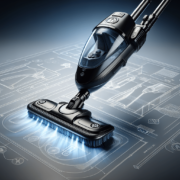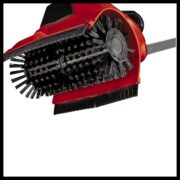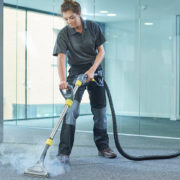In this article, you will learn about the use of steam cleaners in healthcare facilities. We will explore how these cleaners are being used to maintain clean and hygienic environments, and how they can help reduce the spread of infections. By the end of this article, you will have a better understanding of the benefits of using steam cleaners in healthcare settings.
Steam cleaners have become an increasingly popular choice in healthcare facilities for their ability to effectively clean and sanitize various surfaces. These cleaners use high-temperature steam to kill bacteria, viruses, and other pathogens that can cause infections. By using steam cleaners, healthcare facilities can ensure that their equipment, surfaces, and surroundings are thoroughly cleaned, reducing the risk of healthcare-associated infections. Additionally, steam cleaners are eco-friendly alternatives to traditional cleaning methods that often rely on harsh chemicals. So, not only are they effective in maintaining a clean and safe environment, but they are also better for the environment.
Benefits of Steam Cleaners in Healthcare Facilities
Improving Indoor Air Quality
In healthcare facilities, maintaining clean and healthy indoor air quality is of utmost importance. Steam cleaners can play a significant role in achieving this goal. By using high-temperature steam, steam cleaners effectively kill and remove various allergens, dust mites, and bacteria that can circulate in the air, thus reducing the risk of respiratory problems for both patients and staff.
Reducing the Risk of Infections
Infections acquired within healthcare facilities can have severe consequences. Traditional cleaning methods may fail to completely eliminate pathogens, but steam cleaners offer a powerful solution. Steam produced by these cleaners penetrates porous surfaces and kills bacteria, viruses, and fungi on contact, reducing the risk of infections spreading.
Eliminating Harmful Chemicals
Traditional cleaning methods often require the use of harsh chemicals that can have detrimental effects on the environment, as well as on the health of patients and staff. Steam cleaners, on the other hand, only require water to produce steam, eliminating the need for harmful chemicals. This not only promotes a safer and healthier environment but also reduces the risk of chemical exposure.
Enhancing Efficiency and Productivity
Efficiency and productivity are crucial in healthcare facilities, where time is of the essence. Steam cleaners offer a quick and effective cleaning solution, allowing staff to clean larger areas in less time. The high temperature of steam also helps to break down dirt and grime, making it easier to remove. This efficiency translates to improved productivity and more time available for essential patient care.
Steam Cleaners for Disinfection in Healthcare Facilities
Steam Cleaners as a Non-Toxic Disinfection Method
Traditional disinfection methods often involve the use of toxic chemicals that can pose health risks. Steam cleaners offer a non-toxic alternative, utilizing high-temperature steam to kill and eliminate pathogens. This non-toxic disinfection method ensures the safety of patients, staff, and the environment.
Effectiveness Against Various Microorganisms
Steam cleaners have been proven to be highly effective against a wide range of microorganisms, including bacteria, viruses, and fungi. As steam is capable of reaching temperatures above 200 degrees Fahrenheit, it can effectively eliminate even the most stubborn pathogens, ensuring a clean and safe environment for patients and staff.
Eliminating Biofilms and Stubborn Pathogens
Biofilms, which are slimy colonies of microorganisms that adhere to surfaces, can be particularly problematic in healthcare settings. Traditional cleaning methods may not effectively remove biofilms, allowing pathogens to persist and lead to infections. Steam cleaners, however, can penetrate and disrupt these biofilms, effectively eliminating stubborn pathogens and reducing the risk of infections.
Applying Steam Cleaning Techniques in Different Areas
Steam cleaning is a versatile method that can be applied in various areas of healthcare facilities. From patient rooms and operating theaters to waiting areas and restrooms, steam cleaners can effectively clean and disinfect different surfaces. They can be used on hard surfaces, upholstery, mattresses, and even delicate items, providing a comprehensive cleaning solution for various healthcare settings.
This image is property of images.unsplash.com.
Choosing the Right Steam Cleaner for Healthcare Facilities
Considerations for Selecting a Steam Cleaner
When choosing a steam cleaner for a healthcare facility, several considerations should be taken into account. Factors such as steam pressure, temperature control, capacity, and maneuverability are essential. It is also important to consider the specific needs of the facility, the surfaces to be cleaned, and the required accessories and attachments.
Types of Steam Cleaners Suitable for Healthcare Facilities
There are various types of steam cleaners available, including handheld, canister, and steam vacuum cleaners. Each type has its own advantages and limitations. Handheld steam cleaners are compact and portable, making them suitable for smaller areas and spot cleaning. Canister steam cleaners offer higher steam pressure and capacity, making them ideal for larger areas. Steam vacuum cleaners combine steam cleaning with extraction capabilities, providing a deeper clean for carpets and upholstery.
Steam Pressure and Temperature Requirements
The steam pressure and temperature requirements for healthcare facilities may vary depending on the surfaces and pathogens to be treated. Optimal steam pressure should be sufficient to effectively clean and disinfect various surfaces, while the temperature should reach at least 200 degrees Fahrenheit to ensure the elimination of pathogens. It is essential to select a steam cleaner that meets these requirements.
Additional Features and Accessories for Enhanced Cleaning
Certain additional features and accessories can enhance the cleaning capabilities of steam cleaners in healthcare facilities. Attachments such as brushes, nozzles, and extension wands can help reach tight spaces, corners, and crevices. Some steam cleaners also offer adjustable steam settings, allowing for customized cleaning based on the specific surface being treated. These features and accessories contribute to a more thorough and efficient cleaning process.
Safety Precautions and Maintenance of Steam Cleaners in Healthcare Facilities
Training and Education for Staff
Proper training and education are crucial when it comes to utilizing steam cleaners safely and effectively in healthcare facilities. Staff should be trained on the correct operation of steam cleaners, including steam pressure and temperature control, as well as safety precautions to prevent burns or injuries. Regular training sessions should also be conducted to ensure ongoing knowledge and skill development.
Ensuring Proper Ventilation
Using steam cleaners in healthcare facilities may generate heat and humidity, which can affect indoor air quality. Adequate ventilation should be ensured during and after steam cleaning to prevent the buildup of moisture and minimize the potential for mold growth. Good ventilation also helps to eliminate any odors that may be produced during the cleaning process.
Regular Maintenance and Cleaning of Steam Cleaners
Regular maintenance and cleaning of steam cleaners are essential to ensure their optimal performance and longevity. This includes emptying and refilling the water tank as needed, descaling the boiler to remove mineral deposits, and cleaning or replacing filters to maintain proper airflow. Regular inspections should also be conducted to identify any issues or malfunctions that may require professional attention.
Ensuring Electrical Safety and Compliance
Using steam cleaners involves electricity, and safety precautions must be taken to prevent electrical hazards. Steam cleaners should be plugged into grounded outlets and checked for any frayed or damaged cords. It is also important to ensure compliance with electrical safety standards and regulations. Regular checks and maintenance of electrical components are necessary to minimize the risk of electrical accidents.
This image is property of images.unsplash.com.
Integration of Steam Cleaning in Healthcare Facility Cleaning Protocols
Developing Comprehensive Cleaning Procedures
The integration of steam cleaning in healthcare facility cleaning protocols requires the development of comprehensive cleaning procedures. This should include identifying which areas and surfaces require steam cleaning, the frequency of cleaning, and the appropriate steam cleaning techniques. Clear guidelines and protocols should be established to ensure consistency and efficiency in the cleaning process.
Incorporating Steam Cleaning into Daily Routines
To fully utilize the benefits of steam cleaning, it should be incorporated into daily cleaning routines in healthcare facilities. This means designating specific times for steam cleaning and ensuring that staff are trained and prepared to perform the necessary tasks. By incorporating steam cleaning into daily routines, healthcare facilities can maintain a high standard of cleanliness and infection prevention.
Collaboration between Environmental Services and Infection Control
The successful integration of steam cleaning in healthcare facility cleaning protocols requires collaboration between environmental services and infection control departments. By working together, both departments can establish appropriate cleaning frequencies, identify high-risk areas, and ensure that steam cleaning is effectively targeting the elimination of pathogens. Collaboration facilitates a coordinated approach to cleaning, enhancing overall infection prevention efforts.
Monitoring and Evaluation of Steam Cleaning Effectiveness
To ensure the efficacy of steam cleaning in healthcare facilities, monitoring and evaluation should be conducted regularly. This can be done through microbiological testing of surfaces before and after steam cleaning to assess the level of pathogen reduction. Regular feedback from staff and patients can also provide valuable insights into the cleanliness and effectiveness of steam cleaning practices.
Case Studies: Successful Implementation of Steam Cleaners in Healthcare Facilities
Reducing Hospital-Acquired Infections with Steam Cleaners
Several healthcare facilities have successfully implemented steam cleaners as part of their infection control strategies, resulting in a significant reduction in hospital-acquired infections. By incorporating steam cleaning into their cleaning protocols, these facilities have achieved a higher level of cleanliness and disinfection, ultimately improving patient safety and outcomes.
Improved Staff Efficiency and Time Management
The use of steam cleaners in healthcare facilities has shown to improve staff efficiency and time management. With the ability to clean larger areas in a shorter time frame, staff can focus more on patient care and other essential tasks. This increased efficiency also translates to cost savings by reducing labor hours required for cleaning and allowing staff to allocate their time more effectively.
Enhanced Patient Satisfaction and Perception
A clean and sanitary environment is essential for patient satisfaction and perception of healthcare facilities. By implementing steam cleaning, healthcare facilities can provide patients with an environment that is visibly clean, odor-free, and free from harmful pathogens. This can contribute to higher patient satisfaction scores and enhance the overall experience and perception of the quality of care provided.
Cost Savings and Sustainability Benefits
In addition to improving patient satisfaction, the use of steam cleaners can also provide cost savings and sustainability benefits for healthcare facilities. By eliminating the need for harsh chemicals and reducing water consumption, steam cleaning promotes a greener and more sustainable approach to cleaning. Furthermore, the efficiency of steam cleaning can result in reduced labor costs and improved resource management.
This image is property of images.unsplash.com.
Challenges and Limitations of Using Steam Cleaners in Healthcare Facilities
Compatibility with Different Surfaces and Materials
While steam cleaning is highly effective on most surfaces, compatibility issues may arise with certain delicate materials and surfaces. Steam can cause damage to sensitive electronics, fabrics, or certain types of flooring. To overcome this limitation, it is important to select steam cleaners with adjustable steam pressure and temperature settings and to use specialized attachments and techniques for different surfaces.
Operating Constraints in Sensitive Areas
Certain sensitive areas in healthcare facilities, such as operating rooms or isolation units, may have specific operating constraints for cleaning procedures. In these areas, steam cleaning may need to be performed in conjunction with other methods or at specific times to minimize disruptions or risks. Collaboration between healthcare staff, infection control, and environmental services is crucial for developing appropriate cleaning protocols in these sensitive areas.
Addressing Water Residue and Moisture Concerns
Steam cleaning involves the use of moisture, and it is important to address concerns regarding water residue and excess moisture. Proper ventilation and drying techniques should be employed to minimize the presence of moisture, which can contribute to the growth of mold and mildew. Additionally, surfaces that are prone to water damage or are sensitive to moisture should be carefully considered when implementing steam cleaning.
Budgetary Considerations and Return on Investment
The initial investment cost of steam cleaners may pose a challenge for some healthcare facilities. However, it is important to consider the long-term benefits and return on investment. Steam cleaners can contribute to cost savings through reduced chemical usage, increased staff efficiency, and improved infection control. A thorough cost-benefit analysis should be conducted to determine the financial viability of implementing steam cleaners in healthcare facilities.
Emerging Technologies and Innovations in Steam Cleaning for Healthcare Facilities
Advancements in Steam Cleaner Design and Functionality
As technology continues to evolve, steam cleaner design and functionality have also advanced. Newer models offer improved maneuverability, ease of use, and enhanced features such as adjustable steam settings and self-cleaning capabilities. These advancements make steam cleaning more user-friendly and effective, further promoting its utilization in healthcare facilities.
Integration of IoT and Smart Features
The integration of IoT (Internet of Things) and smart features in steam cleaners is another emerging trend. IoT-enabled steam cleaners can provide real-time data and analytics, allowing for better tracking of cleaning activities and performance. Smart features, such as smartphone apps and remote monitoring, streamline the cleaning process and enable facility managers to optimize cleaning schedules and resource allocation.
Combined Technologies for Enhanced Cleaning and Disinfection
Innovation in steam cleaning technology is also leading to the integration of steam cleaning with other cleaning and disinfection methods. For example, some steam cleaners now incorporate UV-C light or ozone generators to enhance the disinfection capabilities. These combined technologies offer a comprehensive approach to cleaning, ensuring thorough and effective elimination of pathogens.
Future Trends and Areas of Research
The use of steam cleaners in healthcare facilities is expected to continue growing as research and development explore new possibilities. Areas of ongoing research include the optimization of steam cleaning parameters, the development of eco-friendly steam cleaning solutions, and the exploration of nanotechnology in steam cleaners. These future trends and advancements hold potential for further improving the efficacy and versatility of steam cleaning in healthcare settings.
Best Practices for Utilizing Steam Cleaners in Healthcare Facilities
Routine Cleaning and Maintenance Schedules
Establishing routine cleaning and maintenance schedules for steam cleaners is essential. Regular cleaning and maintenance ensure that steam cleaners are operating at their optimal performance and prolong their lifespan. This includes regular descaling, filter cleaning or replacement, and proper storage to prevent damage or malfunctions.
Proper Documentation and Record-Keeping
Maintaining proper documentation and record-keeping of steam cleaning activities is important for accountability and quality control. This includes documenting the date and time of steam cleaning sessions, the areas or surfaces cleaned, and any observations or issues encountered. Proper documentation helps to ensure compliance with cleaning protocols and allows for quick identification of any necessary adjustments or improvements.
Continual Staff Training and Education
To maximize the benefits of steam cleaning, staff training and education should be ongoing. Regular training sessions should be conducted to refresh knowledge on steam cleaner operation, safety precautions, and cleaning techniques. Education on infection control principles and understanding the role of steam cleaning in preventing infections should also be provided to staff.
Creating a Culture of Cleanliness and Infection Prevention
Utilizing steam cleaners effectively requires a culture of cleanliness and infection prevention throughout the healthcare facility. This includes promoting good hygiene practices among staff, encouraging proper handwashing, and implementing other infection control measures. By establishing a culture of cleanliness, staff members become more engaged and proactive in maintaining a clean and safe environment for patients.
Conclusion
Steam cleaners have emerged as valuable tools in healthcare facilities, offering a range of benefits that are instrumental in maintaining a clean and safe environment. The improved indoor air quality, reduced risk of infections, elimination of harmful chemicals, and enhanced efficiency contribute to improved patient safety, staff productivity, and overall satisfaction. However, successful utilization of steam cleaners requires careful consideration of specific healthcare facility needs, proper staff training, and ongoing maintenance. As technology continues to advance, combined with ongoing research and best practices, steam cleaning in healthcare facilities will continue to evolve, ultimately driving improved cleanliness, infection prevention, and patient outcomes.






